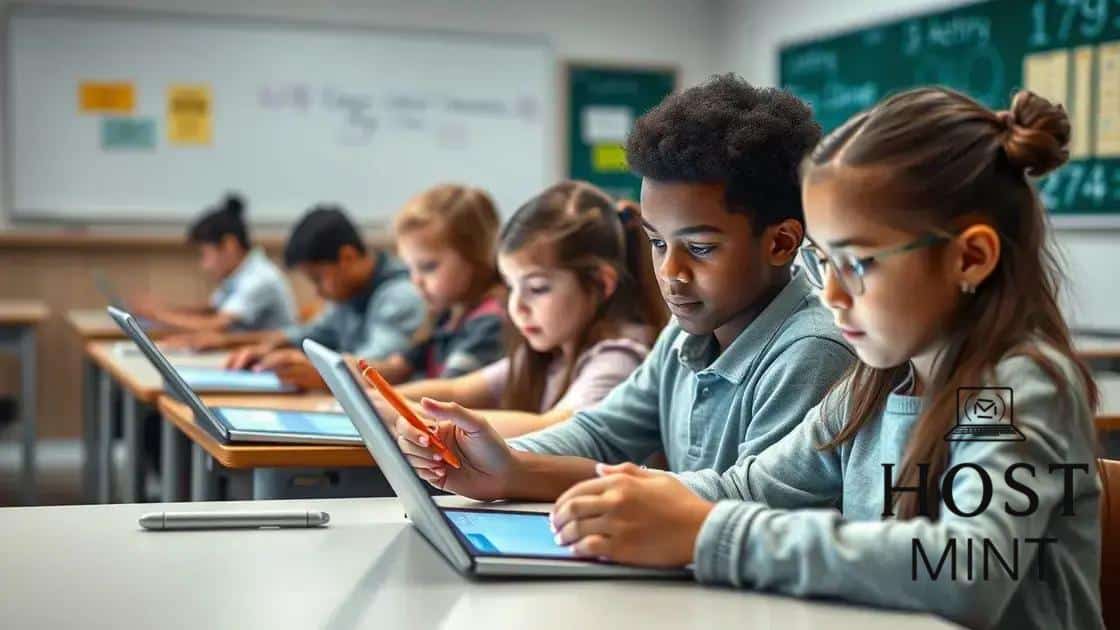How AI is transforming the classroom experience

AI is transforming the classroom experience by personalizing learning, enhancing student engagement through interactive tools, and providing adaptive technologies that support individual needs and improve educational outcomes.
How AI is transforming the classroom experience is a question many educators are asking today. Picture a classroom where learning adapts to each student’s unique needs. This shift is not just a dream; it’s becoming a reality. Let’s dive into how these technologies are shaping education.
Understanding the role of AI in education
Understanding the role of AI in education is crucial as classrooms evolve. Schools around the world are adopting advanced technologies to improve learning.
AI can streamline administrative tasks, giving teachers more time for student engagement. It can also analyze student performance data, helping educators tailor instruction to individual needs.
Benefits of AI in Education
There are several key benefits of incorporating AI:
- Personalized Learning: AI enables teachers to create customized learning pathways for each student.
- Enhanced Feedback: Students receive instant feedback on their performances, helping them learn more effectively.
- Administrative Efficiency: AI reduces the time spent on paperwork, allowing educators to focus on teaching.
Moreover, the integration of AI tools facilitates an engaging learning environment. Intelligent tutoring systems can adapt to students’ abilities, providing additional support where needed.
Challenges in Integrating AI
Despite the advantages, challenges exist:
- Data Privacy: Handling student data responsibly is vital to protect their privacy.
- Cost of Implementation: Schools may face budget constraints in adopting AI technology.
- Training Needs: Educators must be trained to use AI tools effectively.
As AI continues to develop, its role in education will become even more significant. The question remains: how can we harness its potential while overcoming barriers?
Enhancing student engagement with AI tools

Enhancing student engagement with AI tools has become a priority for many educators. AI technologies can create more interactive and personalized learning experiences. For example, AI-driven platforms can adjust content based on student performance and interests.
Interactive Learning Environments
AI tools are designed to foster collaboration and active participation in the classroom. These tools can:
- Encourage Collaboration: Students can work together on projects using AI platforms that promote sharing and communication.
- Boost Motivation: Gamification elements in AI applications make learning more fun, motivating students to participate.
- Provide Instant Feedback: AI can deliver immediate responses to student queries, allowing them to learn at their own pace.
As classrooms incorporate these AI tools, the learning environment becomes more dynamic. Students are not just passive recipients of information; they actively engage and explore.
Real-World Applications
Many schools have started using AI to enhance engagement. For instance, AI tutoring systems provide personalized support. They help identify student strengths and weaknesses, leading to tailored interventions.
Furthermore, virtual and augmented reality experiences powered by AI can transport students to different environments. Imagine learning about ancient history by virtually visiting historical sites. Such experiences can deepen understanding and retention.
As educators continue to integrate AI technologies, the potential to enhance engagement grows. The focus is shifting from traditional teaching methods to innovative solutions that resonate with today’s learners.
Personalizing learning experiences using AI
Personalizing learning experiences using AI is transforming how students engage with content. Through AI technologies, teachers can create customized lessons that meet the unique needs of each student. This adaptability is especially important in diverse classrooms.
How AI Achieves Personalization
AI systems analyze student data, allowing for tailored learning paths. By understanding each learner’s strengths and weaknesses, educators can:
- Adjust Content Difficulty: AI can suggest materials that match a student’s skill level.
- Recommend Learning Resources: Personalized resources help fuel student interest and understanding.
- Monitor Progress: Continuous feedback from AI tools keeps students motivated and on track.
Furthermore, AI can enhance engagement by offering interactive content. For instance, students may receive multimedia presentations that cater to visual or auditory learners.
The Benefits of Personalization
Personalized learning experiences offer numerous advantages. When students learn at their own pace, they often become more invested in their education. As they master concepts, their confidence grows.
This approach also promotes independence. When students are empowered to explore topics that intrigue them, intrinsic motivation increases. Moreover, personalized learning helps minimize frustration for struggling learners, creating a more inclusive environment.
For teachers, AI tools provide valuable insights into student performance. This data informs instruction and helps adapt teaching methods to support all learners effectively.
By continuing to explore the potential of personalized learning through AI, we can foster environments where every student has the chance to succeed.
Challenges of implementing AI in schools
Implementing AI in schools presents several challenges that educators must navigate. While the potential benefits are significant, understanding these obstacles is crucial for successful integration.
Data Privacy Concerns
One major challenge is ensuring the privacy of student data. Schools must protect sensitive information against potential breaches. To address this, many organizations need to establish strict data policies that guide the use of AI.
- Compliance with Regulations: Schools must comply with laws such as FERPA to protect student information.
- Data Management: Issues arise concerning how data is collected, stored, and analyzed.
- Parent and Community Trust: Gaining trust from parents about data usage is essential for successful implementation.
Additionally, educators often require training to harness AI technology effectively. Understanding how to integrate AI tools into their teaching practices can be overwhelming without proper support.
Costs and Funding
Another hurdle is the financial aspect of integrating AI into schools. Budget constraints can limit access to necessary technology, making it difficult for some institutions to implement these innovative solutions.
Many schools may not have the funds to invest in AI tools, leading to disparities in educational resources. Some financial analysis may need to be conducted to identify possible funding sources, such as grants or partnerships.
Moreover, technical support is vital for maintaining AI systems. Schools need dedicated staff who can troubleshoot and ensure that AI tools function as intended. Without this support, the effectiveness of AI may diminish over time.
Despite these challenges, schools can still find ways to make AI integration successful. By addressing privacy concerns and securing funding, educators can create a more enriching learning environment.
Future trends of AI in the classroom
The future trends of AI in the classroom promise exciting changes that can significantly improve education. As technology continues to advance, AI will play an even more critical role in how students learn and interact.
Adaptive Learning Technologies
One of the key trends will be the rise of adaptive learning technologies. These systems will use AI to analyze student data and adjust learning materials accordingly. This personalization ensures students get the support they need at their own pace.
- Individualized Learning Paths: AI will create custom learning experiences based on each student’s strengths and weaknesses.
- Real-Time Assessments: Continuous feedback will help students understand their progress without waiting for formal assessments.
- Engagement Analytics: AI tools will track engagement levels, allowing teachers to modify lessons to maintain interest.
Moreover, the integration of AI-powered virtual reality (VR) and augmented reality (AR) in classrooms will offer immersive experiences. Students can explore complex subjects in engaging ways, enhancing their understanding through hands-on experiences.
Increased Collaboration Tools
Collaboration will become easier with AI as well. Advanced platforms will enable students to work together seamlessly, even when apart. Features like AI-driven chatbots will help facilitate discussions and assist with project management.
Students will be able to engage in meaningful projects that require teamwork and critical thinking. This preparation for the future workforce is essential, as these skills are highly valued in many careers today.
As AI evolves, the focus will also shift towards ensuring ethical usage. Educators will need to instill a sense of digital responsibility in students, guiding them on how to navigate AI technologies safely and effectively.
The landscape of education is changing, and by embracing these future trends, schools can create more engaging, personalized, and effective learning environments for all students.
FAQ – Frequently Asked Questions about AI in Education
How can AI personalize learning experiences?
AI analyzes student data to tailor educational materials and methods according to individual strengths and weaknesses.
What are the challenges of implementing AI in schools?
Challenges include data privacy concerns, budget constraints, and the need for proper training for educators.
How does AI improve student engagement?
AI tools create interactive learning environments, provide instant feedback, and make learning more enjoyable through gamification.
What future trends can we expect with AI in classrooms?
Expect more adaptive learning technologies, increased collaboration tools, and the integration of immersive experiences like virtual reality.






